|
|
|
| My Favourite Planet > English > People > Onatas |
|
| |
Onatas of Aegina
Onatas (Ὀνάτας) was a Greek sculptor from the Aegean island of Aegina, who is thought to have worked in several places in Greece around 480-450 BC, and to have made mainly bronze statues in the Severe style of the early Classical period.
He is known mainly from several mentions by the second century AD Greek travel writer Pausanias, who called him "Onatas, the son of Mikon the Aeginetan" (Ὀνάταν τὸν Μίκωνος Αἰγινήτην) and "contemporary with Hegias of Athens and Ageladas of Argos" (Pausanias, Description of Greece, Book 8, chapter 42, section 10). He reported on statues by Onatas at Olympia, Phigalia in Arcadia, Pergamon and Delphi. A poem by Antipater of Thessalonica mentioned a statue of Apollo by a sculptor named Onatas, who may be the same artist (see below). Inscribed signatures on statue bases found in Athens, Olympia and Pergamon are thought to be those of this Onatas.
Conventionally it is thought that an artist was only named as a son of somebody if the father was also an artist. However, Mikon of Aegina is otherwise unknown. It has been suggested that he may have been the painter and sculptor Mikon the Elder of Athens, thought to have been working in the mid 5th century BC. If this is true, perhaps Mikon was an Aeginetan or had connections to the island, but was or became an Athenian citizen. Otherwise, he may have moved to Aegina, where his son Onatas was presumably born.
Pliny the Elder wrote that in the time of the ancient Greek sculptors bronze manufactured on Aegina was the most highly prized after that of Corinth and Delos, and that it had been used by Polykleitos and Kanachos. [1] Several other sculptors from Aegina were mentioned by ancient authors, particularly Pausanias, and the island appears to have been one of the major centres for sculpture. [2]
Nothing is known about Onatas' style, except that he made a bronze statue of Herakles at Olympia on a colossal scale, around 5 metres high (see below).
At Olympia Onatas worked with a certain Kalliteles (Καλλιτέλης), otherwise unknown, perhaps his son or pupil (Pausanias, Description of Greece, Book 5, chapter 27, section 8), and with Kalamis (Description of Greece, Book 6, chapter 12, section 1). He is also said to have made a statue group for Delphi with Ageladas of Argos or Kalliteles (Description of Greece, Book 10, chapter 13, section 10).
No known surviving ancient sculpture has been securely attributed to Onatas, although scholars continue in their attempts to identify their makers.
Although he is believed to have worked exclusively in bronze, it has been suggested that he may have been responsible for the sculptures of the east pediment of the Temple of Aphaia in Aegina (built around 500 BC, the Niobe page), which are now in the Glyptothek, Munich. There is no literary evidence for this, and since so little is known about his works or style that the hypothesis is imposible to prove. A head of Athena in the Louvre and a Sphinx in the Aegina Archaeological Musueum have also been attributed to him.
Onatas has also been suggested as the sculptor of the "the Artemision Bronze", also referred to as "the God from the Sea", a 209 cm high bronze statue, thought to depict either Zeus or Poseidon. Found in 1926 (left arm) and 1928 (the rest of the sculpture) in a shipwreck off the coast of Cape Artemision, northern Euboea. Dated around 460 BC, a work of the Severe style of the early Classical period. Kalamis, Myron, Kritios and Nesiotes have also been suggested. National Archaeological Museum, Athens. Inv. No. 15161.
Works by Onatas
Works mentioned by Pausanias and Antipater of Thessalonica, and inscriptions thought contain his signature:
Olympia
Phigalia, Arcadia
Pergamon
Delphi
Athens
Plataia, Boeotia |
|
|
| |
| Onatas |
Olympia |
|
 |
|
A group of Greek warriors of the Trojan War
Pausanias reported a statue group by Onatas near the Temple of Zeus in Olympia. Dedicated to Zeus by the people of Achaia in the Peloponnese, the group consisted of statues of eight Greek heroes of the Trojan War, including Agamemnon and Idomeneus, casting lots into Agamemnon's helmet, held by Nestor, to decide who would meet the Trojan prince Hektor's challenge to fight him in single combat (Homer, The Iliad, Book 7, lines 67-200).
Pausanias added that the statue of the ninth voter (the tenth figure), depicting Odysseus, was said to have been taken to Rome by Nero. He also noted the inscriptions of the statue group, including the signature of Onatas, who was described - or described himself - as sophos (σοφος, clever, wise). The fact that he mentioned the signature on only one statue, has led some scholars to wonder if Onatas made the entire group alone.
"There are also offerings dedicated by the whole Achaean race in common; they represent those who, when Hector challenged any Greek to meet him in single combat, dared to cast lots to choose the champion. They stand, armed with spears and shields, near the great temple. Right opposite, on a second pedestal, is a figure of Nestor, who has thrown the lot of each into the helmet. The number of those casting lots to meet Hector is now only eight, for the ninth, the statue of Odysseus, they say that Nero carried to Rome.
But Agamemnon's statue is the only one of the eight to have his name inscribed upon it; the writing is from right to left. The figure with the cock emblazoned on the shield is Idomeneus the descendant of Minos. The story goes that Idomeneus was descended from the Sun [Helios], the father of Pasiphae, and that the cock is sacred to the Sun and proclaims when he is about to rise.
An inscription too is written on the pedestal:
'τῷ Διὶ τἈχαιοὶ τἀγάλματα ταῦτ᾽ ἀνέθηκαν,
ἔγγονοι ἀντιθέου Τανταλίδα Πέλοπος.'
'To Zeus these images were dedicated by the Achaeans,
Descendants of Pelops the godlike scion of Tantalus.'
Such is the inscription on the pedestal, but the name of the artist is written on the shield of Idomeneus:
'πολλὰ μὲν ἄλλα σοφοῦ ποιήματα καὶ τόδ᾽ Ὀνάτα
ἔργον Αἰγινήτεω, τὸν γείνατο παῖδα Μίκων.'
'This is one of the many works of clever Onatas,
The Aeginetan, whose sire was Micon.'"
Pausanias, Description of Greece, Book 5, chapter 25, sections 8-10. At Perseus Digital Library. |
|
|
| |
A colossal bronze statue of Herakles
Onatas made a colossal bronze statue of Herakles, ten cubits tall (around 5 metres), dedicated by the people of Thasos.
"The Thasians, who are Phoenicians by descent, and sailed from Tyre, and from Phoenicia generally, together with Thasus, the son of Agenor, in search of Europa, dedicated at Olympia a Heracles, the pedestal as well as the image being of bronze. The height of the image is ten cubits, and he holds a club in his right hand and a bow in his left. They told me in Thasos that they used to worship the same Heracles as the Tyrians, but that afterwards, when they were included among the Greeks, they adopted the worship of Heracles the son of Amphitryon.
On the offering of the Thasians at Olympia there is an elegiac couplet:
'Υἱὸς μέν με Μίκωνος Ὀνάτας ἐξετέλεσσεν,
Αὐτὸς ἐν Αἰγίνη δώματα ϝαιετάων.'
'Onatas, son of Micon, fashioned me,
He who has his dwelling in Aegina.'
This Onatas, though belonging to the Aeginetan school of sculpture, I shall place after none of the successors of Daedalus or of the Attic school."
Pausanias, Description of Greece, Book 5, chapter 25, sections 12-13. At Perseus Digital Library.
The final sentence has been translated in a number of ways.
"τὸν δὲ Ὀνάταν τοῦτον ὅμως, καὶ τέχνης ἐς τὰ ἀγάλματα ὄντα Αἰγιναίας, οὐδενὸς ὕστερον θήσομεν τῶν ἀπὸ Δαιδάλου τε καὶ ἐργαστηρίου τοῦ Ἀττικοῦ."
"This Onatas, the Aeginetan, was an excellent sculptor, and has left many works, and I think him inferior to none of those of the school which derived from Daedalus established at Athens."
Charles Robert Cockerell, The Temples of Jupiter Panhellenius at Aegina, and of Apollo Epicurius at Bassae near Phigaleia in Arcadia, page 33, note 7. John Weale, London, 1860. At Heidelberg University Digital Library. |
|
|
| |
A statue of Hermes Kriophoros
Assisted by Kalliteles (Καλλιτέλης), who is otherwise unknown, Onatas made a statue of Hermes Kriophoros for the people of Pheneos (Φενεός), a city in Arcadia, northeastern Peloponnese, at the foot of Mount Kyllene, the mythical birthplace of Hermes. The statue stood near the part of the Altis (the sanctuary of Zeus in Olympia) sacred to Pelops, among offerings by Phormis of Maenalus (Φόρμις Μαινάλιος), a general who worked for Gelon, tyrant of Syracuse, Sicily, and later his brother Hieron.
"The Hermes carrying the ram under his arm, with a helmet on his head, and clad in tunic and cloak, is not one of the offerings of Phormis, but has been given to the god by the Arcadians of Pheneus. The inscription says that the artist was Onatas of Aegina helped by Calliteles, who I think was a pupil or son of Onatas."
Pausanias, Description of Greece, Book 5, chapter 27, section 8. At Perseus Digital Library. |
|
|
| |
A chariot for Hieron of Syracuse
Onatas was commissioned by Deinomenes (Δεινομένης), the son Hieron I (Ἱέρων Α΄), the tyrant of Syracuse 478-467 BC (see Big Money at The Cheshire Cat Blog), to make statues to commemorate his dead father's Olympic victory in the four-horse chariot race, and two victories in the horse race. As well as the dedicatory inscription by Deinomenes, Pausanias reported the signature:
"At the time when Xerxes crossed over into Europe, Gelon the son of Deinomenes was despot of Syracuse and of the rest of Sicily besides. When Gelon died, the kingdom devolved on his brother Hieron. Hieron died before he could dedicate to Olympian Zeus the offerings he had vowed for his victories in the chariot-race, and so Deinomenes his son paid the debt for his father.
These too are works of Onatas, and there are two inscriptions at Olympia. The one over the offering is this: 'σόν ποτε νικήσας, Ζεῦ Ὀλύμπιε, σεμνὸν ἀγῶνα
τεθρίππῳ μὲν ἅπαξ, μουνοκέλητι δὲ δίς,
δῶρα Ἱέρων τάδε σοι ἐχαρίσσατο: παῖς δ᾽ ἀνέθηκε
Δεινομένης πατρὸς μνῆμα Συρακοσίου.'
'Having won victories in thy grand games, Olympian Zeus,
Once with the four-horse chariot, twice with the race-horse,
Hieron bestowed on thee these gifts: his son dedicated them,
Deinomenes, as a memorial to his Syracusan father.'
The other inscription is:
'υἱὸς μέν με Μίκωνος Ὀνάτας ἐξετέλεσσεν,
νάσῳ ἐν Αἰγίνᾳ δώματα ναιετάων.'
'Onatas, son of Micon, fashioned me,
Who had his home in the island of Aegina.'
Onatas was contemporary with Hegias of Athens and Ageladas of Argos."
Pausanias, Description of Greece, Book 8, chapter 42, sections 8-10. At Perseus Digital Library.
Earlier Pausanias had described these statues, adding that Onatas had worked with Kalamis (Kalamis 1) on the project:
"Hard by is a bronze chariot with a man mounted upon it. Race-horses, one on each side, stand beside the chariot, and on the horses are seated boys... Onatas the Aeginetan who made the chariot, and Calamis who made the horses on either side and the boys on them."
Pausanias, Description of Greece, Book 6, chapter 12, section 1. At Perseus Digital Library.
See also the bronze charioteer of Delphi, dedicated by Hieron's brother Polyzalos. |
| |
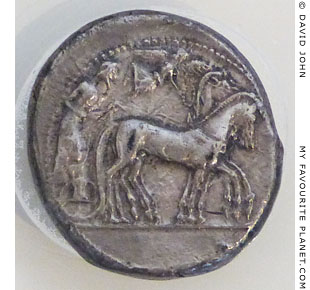
A silver tetradrachm coin of Syracuse,
Sicily, showing a bearded man driving
a chariot (3 horses shown) to the right.
Above him, Nike flies to the right with
a victory wreath in her right hand.
485-465 BC. Provenance unknown.
Numismatic Museum, Athens.
Inv. No. 1910/11, KE 4.
Currently exhibited in the Museum
of the History of the Ancient Olympic
Games, Olympia. |
| |
| |
An inscribed pillar, perhaps
with the signature of Onatas
A limestone pillar found southeast of the Octagon at Olympia, during excavations by the German Archaeological Institute in 1962-1963, inscribed in Aeginetan lettering with a dedication by Pythion, son of Kephalos, of Byzantion, and perhaps the signature of Onatas (see photo below). The rectangular pillar is topped by a slightly projecting rectangular capital. Marks on the top indicate that it supported a small sculpture, perhaps of an eagle. Variously dated to some time between around 550 and 480 BC from the Archaic letter forms, the eight-line inscription has been considered by some scholars to be too early for the assumed dates of Onatas' career. It has been conjecturally restored as: Ὀν̣ά̣[τας ἐ]-
ποίεσεν [Α]-
ἰγινάτας
Πυθίον ἀν-
έθεκε ℎο
Κεφάλο
ℎο Βυζάν-
τιος.
Onatas (?) of Aigina made this.
Pythion, son of Kephalos, of Byzantion, dedicated it.
Inscription SEG 32, 412 at The Packard Humanities Institute.
Olympia Archaeological Museum. Inv. No. 1022.
See:
Peter Siewert and Hans Taeuber (editors), Neue Inschriften von Olympia, Die ab 1896 veröffentlichten Texte, No. 35, pages 91-92. Tyche Sonderband Nr. 7. Verlag Holzhausen, Vienna, 2013. PDF at the OAPEN Foundation, National Library, The Hague.
Antony E. Raubitschek, A new signature of Onatas. In: José Dörig, Onatas of Aegina, page 30. H. F. Mussche (editor), Monumenta graeca et romana 1, Volume 1. Brill, Leiden, 1977.
Classical Sculptors' Signatures database No. 1925 at the Beazley Archive, Oxford. |
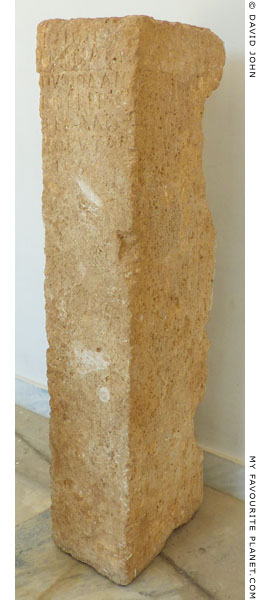
The inscribed limestone pillar in
the entrance porch of Olympia
Archaeological Museum.
Around 550-480 BC. |
| |
| |
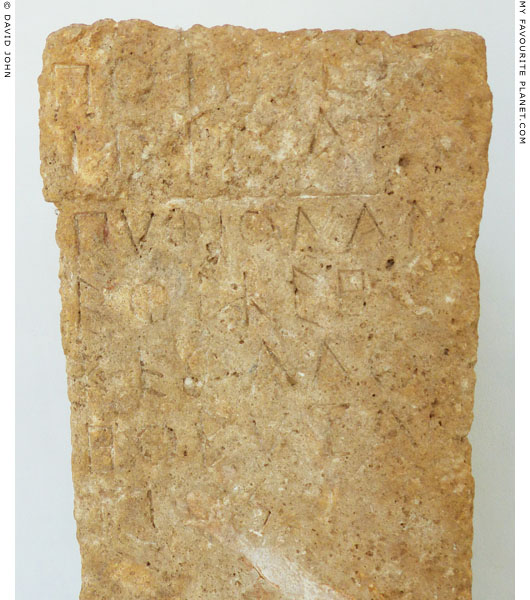
The badly worn inscription at the top of the front of the pillar in Olympia. |
| |
| Onatas |
Phigalia in Arcadia |
|
 |
|
A bronze statue of Demeter Melaine
"About two generations after the Persian invasion of Greece" (480 BC), "Onatas of Aegina, son of Micon" made a bronze statue of Demeter Melaine (Μέλαινη, the Black One) "at a price" (i.e. a high price) for her cave sanctuary on Mount Elaion (Ἐλάιον), near Phigalia (Φιγαλία) in Arcadia. He modelled it on an ancient xoanon (cult statue) which had been destroyed by fire.
"The image, they say, was made after this fashion. It was seated on a rock, like to a woman in all respects save the head. She had the head and hair of a horse, and there grew out of her head images of serpents and other beasts. Her tunic reached right to her feet; on one of her hands was a dolphin, on the other a dove. Now why they had the image made after this fashion is plain to any intelligent man who is learned in traditions.
They say that they named her Black because the goddess had black apparel."
Following the destruction of the original statue, the Phigalians had neglected the worship of the goddess until their land became barren. They sent representatives to seek advice from the oracle at the Temple of Pythian Apollo at Delphi, where they were told to appease the goddess by resuming their offerings at her sanctuary.
"When the Phigalians heard the oracle that was brought back, they held Demeter in greater honour than before, and particularly they persuaded Onatas of Aegina, son of Micon, to make them an image of Demeter at a price. The Pergamenes have a bronze Apollo made by this Onatas, a most wonderful marvel both for its size and workmanship. This man then, about two generations after the Persian invasion of Greece, made the Phigalians an image of bronze, guided partly by a picture or copy of the ancient wooden image which he discovered, but mostly (so goes the story) by a vision that he saw in dreams. As to the date, I have the following evidence to produce."
Pausanias' evidence was the story of the statues that Onatas and Kalamis made at Olympia for Deinomenes of Syracuse after the death of his father Hieron (see above), which he said occurred "at the time when Xerxes crossed over into Europe".
"It was mainly to see this Demeter that I came to Phigalia." But when Pausanias arrived at the cave sanctuary of Demeter on Mount Elaion he discovered that the statue had been destroyed by a rock fall from the roof of the cave, apparently so long before "that most of the Phigalians were ignorant that it had ever existed at all".
Pausanias, Description of Greece, Book 8, chapter 42. At Perseus Digital Library.
See also the article in Demeter and Persephone part 1. |
|
|
| |
| Onatas |
Pergamon |
|
 |
|
A colossal bronze statue of Apollo
Pausanias was impressed by a bronze statue of Apollo by Onatas in Pergamon.
"The Pergamenes have a bronze Apollo made by this Onatas, a most wonderful marvel both for its size and workmanship."
Pausanias, Description of Greece, Book 8, chapter 42, section 7.
A sculptor named Onatas was mentioned in an epigram by Antipater of Thessalonica (Ἀντίπατρος ὁ Θεσσαλονικεύς), governor of Thessaloniki during the reign of Augustus (27 BC - 14 AD). The poem praises a bronze statue of Apollo by Onatas, perhaps the work in Pergamon mentioned by Pauanias.
"Apollo is a big boy here in this bronze work of
Onatas which testifies to the beauty of Leto and
Zeus, and proclaims that not idly did Zeus love her,
and that, even as the saying is, the eyes and head of
the son of Cronos are glorious. Not even Hera will
be displeased with this bronze which Onatas moulded
to such beauty by the help of Ilithyia."
William Roger Paton (translator), The Greek Anthology, Volume III (of 5), Book IX Epigrams, No. 238, pages 124-125. In Greek and English. William Heinemann, London; G.P. Putnam's Sons, New York, 1925. At the Internet Archive.
Pausanias' remark that the statue in Pergamon was extraordinary for its size as well as the workmanship, and Antipater's description of Onatas' bronze Apollo as a "big boy" have led scholars to believe that the statue was colossal in scale. It has also suggested that it may have been taken to Pergamon from Greece as war booty, perhaps by Attalus I, who purchased Aegina from the Aetolian League for 30 talents in 210 BC (see History of Pergamon).
Part of an inscribed marble statue base found on the Pergamon acropolis in 1886, and dated 197-159 BC, may have belonged to the pedestal on which the bronze Apollo stood ( see below).
A marble torso now in Munich is thought to be part of a statue of Apollo. It has been suggested that it may have been a copy of the Apollo by Onatas in Pergamon. Glyptothek, Munich. Inv. No. 265. Height 76.5 cm. |
|
|
| |
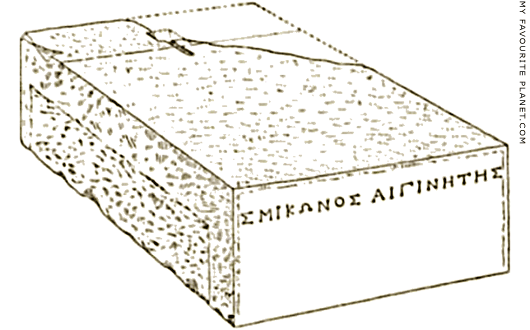
Part of an inscribed marble statue base from Pergamon. It is thought that other marble
slabs stood on each side and top of it, and that the whole inscription included the
signature of Onatas. Perhaps part of the pedestal on which his bronze Apollo stood.
Circa 197-159 BC. Found in May 1886 on the slope between the Temple of Dionysus and
the cavea (audience seating area) of the theatre on the Pergamon acropolis. Bluish
white marble. Height 21.5 cm, width 42.5 cm, depth 62 cm; height of letters 1.8 cm.
The surviving letters: ΣΜΙΚΩΝΟΣ ΑΙΓΙΝΗΤΗΣ, conjecturally restored as:
[Ὀνάτα]ς Μίκωνος Αἰγινήτης [ἐποίησεν].
[Onata]s son of Mikon the Aeginetan [made me].
Inscription IvP I 48 (OGIS 286) at the Packard Humanities Institute.
Pergamon Museum, Berlin. Inv. No. III 531.
The name on the slab has also been read as Σμίκωνος (Smikon),
suggested as an alternative spelling to the name of Onatas' father.
Source: Max Fränkel (editor), Altertümer von Pergamon, Band VIII, Die Inschriften von
Pergamon, I: Bis zum Ende der Königszeit, No. 48, page 41. W. Spemann, Berlin, 1890.
At Heidelberg University Digital Library. |
| |
| Onatas |
Delphi |
|
 |
|
A military statue group dedicated by the Tarentines
At Delphi, Pausanias reported a statue group by Onatas of Aegina and another sculptor, perhaps Ageladas of Argos, depicting cavalry and infantry standing by Taras and Phalanthos bestriding the slain native king Opis, dedicated by the city of Taras (Τάρας; Latin, Tarentum; today, Taranto) in Apulia, southern Italy.
"The Tarentines sent yet another tithe to Delphi from spoils taken from the Peucetii, a non-Greek people. The offerings are the work of Onatas the Aeginetan, and Ageladas the Argive, and consist of statues of footmen and horsemen – Opis, king of the Iapygians, come to be an ally to the Peucetii. Opis is represented as killed in the fighting, and on his prostrate body stand the hero Taras and Phalanthus of Lacedaemon, near whom is a dolphin. For they say that before Phalanthus reached Italy, he suffered shipwreck in the Crisaean sea, and was brought ashore by a dolphin."
Pausanias, Description of Greece, Book 10, chapter 13, section 10. At Perseus Digital Library.
However, the Greek text is corrupt and the name of the second artist is unclear. It has also been interpreted as Kalliteles (Καλλιτέλης) or Kalynthos (Κάλυνθος). Kalliteles appears to have been suggested because Pausanias mentioned him as Onatas' assistant on the statue of Hermes Kriophoros at Olympia see above.
Kalynthos is otherwise unknown as an artist in ancient literature, and the name was apparently suggested because it may be on a fragment of an inscription from a marble statue base found on the Athens Acropolis. None of the words or names on the three small surviving fragments of the monument are complete, but have been speculatively restored as:
[Κάλ]υνθος [κα]-
[ὶ Πολ]ύτιμ[ος]
[ἀ]νε[θ]έτε[ν]
τὸ Τ[— c.7 —].
[Διοπεί]θε[ς]
[ἐποίεσ]εν.
Kalynthos (?) and Polytimos (?) dedicated this. Diopeithes (?) made it.
Antony E. Raubitschek, Dedications from the Athenian Akropolis [DAA], No. 279. At the Packard Humanities Institute. [3]
Epigraphical Museum, Athens.
Inv. No. EM 6397, fragment a, found near the Propylaia; fragment b, found between 1877 and 1886 near the North Wall of the Athens Acropolis.
Inv. No. EM 6453, fragment c, found between 1877 and 1886 near the North Wall.
Even if the name Kalynthos is correct, he was only the dedicator and not the maker. Suggestions that he and Polytimos were brothers and artists are pure conjecture. |
|
|
| |
| Onatas |
Athens |
|
 |
|
| |
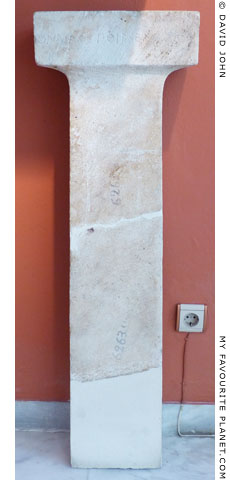 |
 |
A pillar dedicated by Timarchos and the signature of the sculptor Onatas inscribed on the
cavatto capital in Attic lettering. It supported a bronze statuette, perhaps of a horse.
Early 5th century BC. Found in 1887, near the North Wall of Athens Acropolis,
between the Erechtheion and the Propylaia. Pentelic marble. Height 85 cm.
Τίμαρχος ⋮ μ’ ἀνέθεκε [⋮] Διὸς [⋮] κρατερόφρ[ονι ⋮ παιδὶ]
μαντειο͂ν [⋮] φρασμοσύναι [⋮] μετρὸς [⋮] ἐπ[ευχσαμένες].
Ὀνάτας ἐποίεσεν.
Timarchos dedicated me to the dauntless daughter of Zeus, aware of
the warnings of the oracles and in accordance with a vow of his mother.
Onatas made it.
Inscription IG I² 503 (Also IG I³ 773; CEG 1.243; Antony E. Raubitschek,
Dedications from the Athenian Akropolis [DAA], No. 236 [see note 3]).
Epigraphical Museum, Athens. Inv. No. EM 6263. |
|
| |
A fragment of another inscribed pillar, found near the north wall of the Athens Acropolis, and dated to the early 5th century BC, is also thought to be signed by Onatas. The inscription was conjecturally restored by Antony E. Raubitschek as:
[Ὀνάτας] ἐποίεσεν.
[— — — — — —]ος ἀνέθεκεν τἀθ[εναίαι ἀπαρχέν].
Antony E. Raubitschek, Dedications from the Athenian Akropolis [DAA], No. 257. At the Packard Humanities Institute.
Epigraphical Museum, Athens. Inv. No. EM 6280.
See also: Classical Sculptors' Signatures database No. 2302 at the Beazley Archive, Oxford. |
|
|
| |
| Onatas |
Plataia, Boeotia |
|
 |
|
Onatas as painter?
Pausanias mentioned paintings at Plataia, including two by an artist named Onasias (Ὀνασίας). However, the name in the first passage in the Greek manuscript has been read as Onatas (Ὀνάτας). It was thus considered that the name in the second passage was an error, and should also be Onatas. From this it was thought that Onatas may also have been a painter. On the other hand, some scholars have believed that both passages should read Onasias.
"In the temple [of Athena Warlike] are paintings: one of them, by Polygnotus, represents Odysseus after he has killed the wooers; the other, painted by Onasias, is the former expedition of the Argives, under Adrastus, against Thebes. These paintings are on the walls of the fore-temple, while at the feet of the image is a portrait of Arimnestus, who commanded the Plataeans at the battle against Mardonius, and yet before that at Marathon."
Pausanias, Description of Greece, Book 9, chapter 4, section 2. At Perseus Digital Library.
"... and moreover, Onasias painted a picture at Plataea of Euryganeia bowed with grief because of the fight between her children."
Pausanias, Description of Greece, Book 9, chapter 5, section 11. |
|
|
| |
| Onatas |
Notes, references and links |
 |
|
1. Pliny the Elder on bronze
Pliny the Elder, Natural History, Book 34, chapter 5. At Perseus Digital Library.
Pliny's mention of "bronze that was fused at Aegina" by Kanachos is in Book 34, chapter 19. It is not clear to which Polykleitos or Kanachos he was referring, but they are thought to have been Polykleitos the Elder and Kanachos the Elder, both 5th century BC.
When discussing bronze (often translated more generally as "brass") and sculptures made from the metal in Book 34, Pliny was generally writing about historical periods long before his own lifetime (first century AD). He said that the art of bronze-making had died out between the time of sculptors such as Kephisodotos the Younger, in the late 4th - early 3rd century BC, and was revived in the 156th Olympiad (154 BC).
"The practice of this art then ceased for some time, but revived in the hundred and fifty-sixth Olympiad, when there were some artists, who, though far inferior to those already mentioned, were still highly esteemed; Antaeus, Callistratus, Polycles, Athenaeus, Callixenus, Pythocles, Pythias, and Timocles."
Book 34, chapter 19.
He also wrote that by his time of the art of making fine Corinthian bronze had been lost, and that ancient works made of the metal had been transformed by their wealthy Roman owners into banal objects such as "trulleos", which may have meant chamber pots, but has been translated as "washing-basins".
"The only genuine Corinthian vessels, then, are those which these men of taste metamorphose, sometimes into dishes, sometimes into lamps, or even into washing-basins, without any regard to decency."
Book 34, chapter 3.
2. Aeginetan sculptors
Pausanias referred several times to an "Aeginetan school", a distinctive "Aeginetan style" and "Aeginetan workmanship": "The fashion of the workmanship is what the Greeks call Aeginetan." (Description of Greece, Book 8, chapter 53, section 11) He was probably referring to Archaic statues he saw, which he compared to Egyptian and ancient Attic works (Book 1, 42, 58 and Book 7, 5, 5).
Other Aeginetan sculptors mentioned by Pausanias:
Anaxagoras of Aegina
Aristonos (Ἀριστόνος) of Aegina
Glaukias of Aegina
Kallon of Aegina
Philotimos of Aegina (Φιλότιμος Αἰγινήτης)
Ptolichus (Πτόλιχος), son and pupil of Synnoon of Aegina
Serambos (Σήραμβος), also a native of Aegina
Simonos (Σίμωνος) of Aegina
Smilis (Αἰγινήτης Σμῖλις), son of Eucleides (Εὐκλείδος). He made the cult statue of Hera for the Temple of Hera in Samos. "This Smilis was a contemporary of Daidalos, though of less repute." Pausanias, Description of Greece, Book 7, chapter 4, section 4.
Synnoon (Συννοών) of Aegina, pupil of Aristokles of Sikyon (brother of Kanachos the Elder)
Theopropos (Θεοπρόπος) of Aegina
3. Raubitschek, Dedications from the Athenian Akropolis
Raubitschek, Antony E., with the collaboration of Lilian H. Jeffery, Dedications from the Athenian Akropolis: A catalogue of the inscriptions of the sixth and fifth centuries B.C. (usually abbreviated as DAA). Archaeological Institute of America, Cambridge, Mass., 1949. Links to the online edition at the Hathi Trust website. |
|
|
| Photos and articles © David John, except where otherwise specified. |
 |
Visit the My Favourite Planet Group on Facebook.
Join the group, write a message or comment,
post photos and videos, start a discussion... |
|
|
| |
|
|
| |
| |
 |
| |
 |
| |
 |
| |
 |
| |
 |
| |
 |
| |
George Alvanos
rooms in
Kavala's historic Panagia District
Anthemiou 35,
Kavala, Greece
kavalarooms.gr
|
| |
Olive Garden Restaurant
Kastellorizo,
Greece
+30 22460 49 109
kastellorizo.de
|
| |
Papoutsis
Travel Agency
Kastellorizo,
Greece
+30 22460 49 286
greeklodgings.gr
|
| |
|